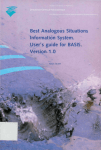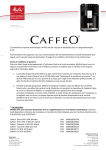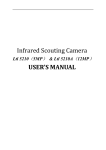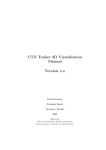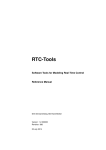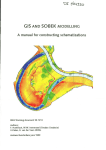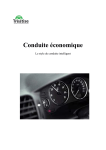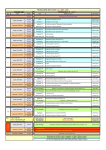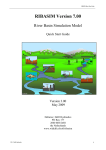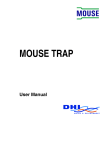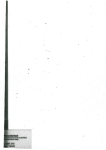Download pdf-document
Transcript
SOBEK-RE exercises Handout SOBEK February 2007 1 Chapter 1 Introduction 1.1 Introduction This is the user manual for the exercises of the River Systems & River Dynamics (Module 5) course at the Unesco-IHE. The main goal of these exercises is to get experience with morphological modelling. The one-dimensional SOBEK-RE modelling system is used for this exercise. This system has been developed by WL | Delft Hydraulics and Rijkswaterstaat RIZA, and is used for understanding and predicting river behaviour. More information can be found at www.sobek.nl. Note: this exercise has been designed and applied at the Delft University of Technology, part of the course CT5311 on River Dynamics. 1.2 Contents Chapter 2 gives a short introduction into SOBEK-RE. The set-up of a new model is discussed in Chapter 3. This knowledge is needed for both exercises. The two exercises are presented in Chapters 4 and 5 respectively. The first one, 'Local shoal', can be considered as a basic introduction to the modelling system and the type of morphological processes that are reproduced. You have to do all 'model steps': bathymetry, boundaries, runs, interpretation of the results, etc. The second exercise 'Bifurcation' is more complex. The schematisation of this exercise will be made available to you. You have to analyse the effects of management strategies on the morphological behaviour of the river. 1.3 Information For questions please contact: dr. ir. Kees Sloff (WL | Delft Hydraulics, phone 015-2858585, [email protected]) 2 Chapter 2 Description of SOBEK 2.1 Introduction SOBEK is a one-dimensional modelling system for open-channel networks. It can be used to simulate unsteady and steady flow, (uniform and graded) sediment transport, morphology, salt intrusion, and water quality. SOBEK is developed by WL DELFT HYDRAULICS and Rijkswaterstaat RIZA (Rijksinstituut voor Zoetwaterbeheer en Afvalwaterbehandeling), in The Netherlands. Presently there are two versions for river applications: SOBEK-RE: the original version to be used for this SOBEK Exercise, in which “RE” refers to Rivers and Estuaries. This version was developed in the period between 1995 and 2000, and remained unaltered since then. SOBEK-RE is still used for the morphological model, but will be replaced in the future by SOBEK-RIVER. Figure 1 Graphical User Interface of SOBEK-RE SOBEK-RIVER is the new version of SOBEK, capable of simulating 1D channel flow and 2D flooding. It is part of the new product line of SOBEK, which integrates all modules in a GIS environment. Although it is more user-friendly and more flexible than the SOBEK-RE, it does not yet contain an ‘easy to use’ morphological module. Therefore SOBEK-RE is chosen as tool for this exercise. 3 Figure 2 Graphical User Interface of SOBEK-RIVER (GIS based) 2.2 Hardware Sobek can be used on a PC with MS-Windows. For normal applications SOBEK needs at least a Pentium II processor or higher. The PC version can only be used with a hardware key. Unauthorized use is not possible. 2.3 Equations Water motion In Sobek the one-dimensional mass balance and momentum balance for water motion are solved. Without wind and density differences, these equations read: At t Q t Q x x in which: Q t x B Af At g h (1) 0 Q2 B Af gAf h x gQ Q C 2 RA f (2) 0 = discharge [m3/s] = time [s] = distance [m] = Boussinesq coefficient [-] = cross section with flow [m2] = total cross section [m2] = acceleration due to gravity [m/s2] = water level [m] 4 C R W = Chézy coefficient [m1/2/s] = hydraulic radius [m] = flow width [m] Note that in a situation with steady-uniform flow the water depth approaches the normal depth value. The normal depth follows from equation (2) by eliminating the accelaration and convection terms, and replacing the surface slope h x by the bed slope i [m/m]: hn Q2 W 2C 2i 3 The flow velocity u then follows from the continuity equation: Q=Wuhn Sediment transport A sediment transport formula can be selected, for instance Engelund-Hansen or MeyerPeter-Müller. Often sediment transport formulas can be rewritten as a power law of the flow velocity: s aub (3) in which s a b u = sediment transport per unit width, excluding pores [m2/s] = coefficient [m2-b/s1-b] = exponent representing the degree of nonlinearity [-] = current velocity [m/s] In transport formulas in SOBEK the Shields parameter is often the governing parameter. It is defined as: u2 C 2 D in which: D h i D = characteristic grain size of bed material [m] = relative density of sediment (for sand = 1.65) [-] = Shields parameter [-] The formula of Engelund and Hansen can be written (for transport without pores) as: s 0.05 g D503 in which: u* D50 C2 g 5/ 2 0.05 u5 gC 3 2 D50 = shear velocity = (u· g)/C [m/s] = median grain size of bed material [m] 5 Engelund and Hansen is valid for situations in which ws/u* < 1, 0.19 < D50 < 0.93 mm, and 0.07 < < 6 (in which ws is the fall velocity) The formula of Meyer-Peter and Müller is defined as: s = 8 Dm3/ 2 g in which: Dm 0.047 3/ 2 = mean grain size of bed [m] = ripple factor = (C/C90)3/2 [-] = grain roughness = 18·log(12h/D90) C90 It is valid for situations in which ws/u* > 1, Dm > 0.4 mm, and < 0.2. To obtain the sediment-transport rate including pores, it is necessary to multiply the equations above with a factor 1/(1- p) in which p is the porosity of the bed (in the order of 0.4). Output of sediment-transport rates from SOBEK-RE is presented as transport including pores. Bed level For the bed level, the sediment transport balance in SOBEK is used for the total cross section: 1 1 p A t S x in which: A S (4) 0 = area of cross section [m2] = sediment transport through a cross section [m3/s] = fraction of pores [-] p For a constant width, this equation reduces to: 1 1 p zb t in which: zb s s x (5) 0 = bed level [m] = sediment transport per unit width, excluding pores [m2/s] For these balance equations de Vries (1965) has shown that small-scale disturbances propagate in flow direction with a speed cb following from the method of characteristics: cb um in which b Fr 1 Fr 2 where ds / du h b S and cb in [m/s] Q = power of transport formula (see equation 3) = Froude number = u (gh) 6 Chapter 3 Model set-up 3.1 Starting SOBEK Sobek has been installed on the network. Start the SOBEK software and open a new project and save this project directly with a new name, e.g. "ex1". Then, open the 'empty case' and save this case with a new name, e.g. "ex1". You see three yellow boxes at the lefthand side: Model schematisation, Hydraulic computation, Hydraulic results. These boxes can be entered by clicking on them. Each box is discussed separately in the next subsections. The other boxes on the screen are not used during these exercises. 3.2 Model schematisation 3.2.1 Model attributes When building a new model, go first to 'Model Attributes' under 'File'. On this screen, parts of SOBEK can be activitated for the current case. For case 'Local shoal' 'River', 'Water Flow', 'Sediment Transport' and 'Morphology'. Besides, the geographical area must be specified in this window. Choose a sufficiently large area for your model. Specify the 'Geographical Area' of the river in X and Y coordinates Then, the model schematisation itself should be specified in the Select Layer window at the right hand side. The following parts are important for this exercise: 3.2.2 Nodes, branches and cross-sections Mind the difference between nodes, branches and cross sections: A node is only used for an internal bifurcation or confluence or an external boundary. These nodes are defined in the horizontal plane and only have an xand y-coordinate. Between two nodes, a branch is defined. It represents the actual river channel between bifurcations, confluences or boundaries. Many models consist of one branch only! Cross sections are defined to prescribe the (varying) bed levels and widths of the cross-sectional profile along a branch or river. 7 <Topography>: Defining nodes and branches: with these nodes and the branches, the topography in the horizontal plane is defined (see Figure 3). Nodes: Specify the nodes of the river by giving a name and the coordinates in X and Y. Branches: Specify the branches of the river by giving a begin and end node Branch 1 Node 1 (x1,y1) Figure 3 Node 2 (x2,y2) Definitions of nodes and branches Thereafter, the cross section must be defined. The definition is split into two parts: <Definitions>: cross section shape (width versus distance from the lowest point in the cross section) Define the cross-section of the river. Start with the 'level width table' by clicking on 'tabulated' (see Figure 2). <CrossSections>: cross section location (and height) Define the location and the reference level of the cross section. Determine first how many locations must be given and if you would use a slope (“slope” is only necessary if SOBEK cannot determine the slope from interpolation between two cross-sections on a branch). The reference level is used to determine the height of a cross-section relative to a reference level (only if the height had not been set yet relative to this reference in ‘descriptions’). Each river branch must have at least one cross-section at a certain distance from the begin node with a specified height. More than one cross-section should be defined in a river branch if the cross-sections are not uniform or if the slope is not uniform (see figure 4). 8 Figure 4 Definition of cross-sections 3.2.3 Friction Define the roughness predictor. Give values for 'flow' and 'reverse flow'. Although the river flow in a situation without tidal influence has always the same direction, the roughness must be given for both directions. 3.2.4 Conditions Boundary conditions: Specify the boundary conditions for ‘water flow’ and ‘morphology’. You can also specify lateral discharges, dredging etc. Although a river without tidal influence only needs a condition for the bed level or the sediment transport at the inflow boundary, SOBEK also requires a boundary condition at the outflow boundaries. Set the sediment transport rate at this boundary at zero. Initial Conditions: Specify initial conditions and grain sizes. Note that if a sediment transport formula is selected (see later), SOBEK will only ask for the grain size required by that particular formula. Otherwise all grain sizes (D35, D50, Dm and D90) are required. 3.2.5 Numerical grid To generate a grid with constant mesh size, it is necessary to specify the grid size ('distance') and generate a grid. 3.2.6 Run time data Time Parameters: Specify the begin and end time (note the format!) and the time step. 9 Numerical Parameters: Change the calculation mode into ‘Steady’ (for quasi-steady simulations). F(x), F(t) reports: Specify the parameters and time steps for your output. If you change the simulation time or computational time step, you should probably also change the output time step etc.! The output ‘time step’ indicates the number of computational time steps after which output is written to file (and is therefore not expressed in a time unit, such as hours). 3.2.7 Transport formula Choose a sediment transport formula which is suitable for your problem. 3.2.8 Validation Once all the input has been specified, the model input can be validated by using 'Operations' and 'Validate model'. If all data are correct, you can leave the 'Model schematisation' and go to 'Hydraulic computation'. 3.3 Hydraulic computation Start the simulation in the box 'Hydraulic computation'. When an error occurs, go back to 'Model schematisation' to check your input. When the computation does not give error messages, go to 'Hydraulic Results' to interpret the numerical results. 3.4 Hydraulic results The results of the computations can be visualized by clicking the box 'Hydraulic results'. First, select an output file, e.g. the flow output or the morphology output. Then, make graphs of the most important variables, e.g. the bed level development and the current velocity. The parameters can be plotted in time as well as space. The graphs can be printed or copied to other applications. 10 Chapter 4 Local shoal 4.1 Problem description An alluvial river section has a length of 10 km. After heavy rains, sand from a nearby hill slides down into the river and forms a local shoal. This shoal makes navigation more difficult. The river manager would like to know how this shoal will develop in the near future. (S)he asks your advice for this river problem. 4.2 Information The situation after the landslide is as follows: longitudinal bed level profile 1.2 0.95 1.00 1 0.90 z (m) 0.8 0.6 0.45 0.60 0.4 0.2 0.00 0 0 1 2 3 4 5 6 7 8 9 10 x (km) The sand of the shoal is equal to the sand of the rest of the river bed. Discharge Width Slope Chézy roughness Grain size : Q = 1000 m3/s : B = 200 m : i = 10-4 : C = 50 m1/2/s : D50 = 0.2 mm (ws50 = 0.04 m/s) 11 11 4.3 Analytical exercises Calculate the (equilbrium) water depth and the flow velocity in the undisturbed river section. Choose a transport formula (Engelund-Hansen of Meyer-Peter-Müller), and give a motivation. Calculate the annual sediment load, s (m2/s) Compute the propagation velocity of a bed disturbance Choose the spatial step, x Choose the time step, t Choose the simulation period Information in the the book Principles of River Engineering (Jansen et al, 1979). 4.4 Simulations with SOBEK Simulate the problem with the SOBEK-software 4.5 Exercises How many equations does SOBEK solve dynamically? Which model variables are computed dynamically in SOBEK? Which initial and boundary conditions are needed for your simulation? Draw the propagation velocity of the top of the shoal as a function of time. Is the numerical propagation velocity equal to the analytical propagation velocity? Why? Does the shape of the shoal change in time? Why? Simulate the same problem for median grain sizes of 0.4 mm and 0.1 mm (twice and half the reference value). Use the same transport formula! What is the sensitivity of the propagation velocity of the shoal when you increase or decrease the median grain size? Can you explain this by using the transport formula? 12 Chapter 5 Bifurcation 5.1 Problem definition River discharge Branch 2 Lake with constant water level Branch 1 Branch 3 Optional side channel Nevengeul A river splits into two branches before debouching into a lake with a constant water level. In this river system, two types of measures are being considered. The first type regards four options of dredging to improve navigation, either by one-time deepening (options B1 and B2) or by continuous sediment withdrawal (options B3 and B4). The second type of measures regards four options of side channels for purposes of nature rehabilitation. It is assumed that the side channels convey only water and do not extract any sediment from the main river. All options of dredging and side channels are summarized in Table 1. Table 1 Options of dredging and side channels Dredging Side channel D1, one-time deepening in upper Branch 2: S1, 100 m3/s discharge from Branch 2: 1 m lowering of bed level over reach between reach between 10 and 20 km from 0 and 25 km from bifurcation bifurcation D2, one-time deepening in lower Branch 2: S2, 150 m3/s discharge from Branch 2: 1 m lowering of bed level over reach between reach between 20 and 30 km from 25 and 50 km from bifurcation bifurcation D3, continuous sediment withdrawal from upper S3, 200 m3/s discharge from Branch 3: Branch 3: reach between 5 and 15 km from 3 0.001 m /s at 5 km from bifurcation bifurcation D4, Continuous sediment withdrawal from middle S4, 100 m3/s discharge from Branch 3: part of Branch 3: reach between 15 and 25 km from 0.001 m3/s at 15 km from bifurcation bifurcation As a river engineer, you are asked to advise about the short-term effects of these measures (first weeks after implementation) as well as the long-term morphological effects (50 year). 13 You only need to analyse one combination of a dredging option (D) and a side channel option (S). Please select two options from Table 1. 5.2 Data The model is already available at your computer. The input has been based on the data and calculations below: Data B1 = 300 m L1 = 50 km i1 = 1*10-4 C1 = 50 m1/2/s B2 = 150 m L2 = 50 km C2 = 50 m1/2/s B3 = 100 m L3 = 50 km C3 = 50 m1/2/s At the upstream boundary the discharge is constant and equal to 2500 m3/s. The median grain size is equal to 0.3 mm for the entire area. The equilibrium situation for Branch 1 can be easily calculated from the parameter values given above: Q1 Buh (6) Bhe1C Ri This gives: he1 R1 Q12 B 2C 2 Ri 6.34 m 6.62 m Please recall that there are eight unknown variables downstream of the bifurcation, four at each branch, i.e. equilibrium depth, slope, discharge and sediment transport rate. Eight equations are needed to solve these variables. They are given in Equations (7) to (14) below. Water motion: 1 1 Q2 B2 Che 2 Re22 ie22 Q3 B3Chc Re23ie23 (7) 1 1 (8) 14 Sediment transport: n n n 2 2 e2 e2 S2 B2 mC R i S3 B3mC n Re23ie23 (9) n n (10) Continuity equations (sediment transport, discharge and water level): S1 S2 S3 Q1 ie 2 Q2 ie 3 Q3 (11) (12) (13) A bifurcation relationship or “nodal point relation” is needed for the sediment transport distribution at the bifurcation: S2 S3 B2 Q2 B3 Q3 k (14) For a stable solution (i.e. both branches open!), k must be larger than n/3. Here k = 5 is used. By iteration, the solution can be found (Table 2): Table 2 Solution of the bifurcation problem Parameter Branch 1 Branch 2 Branch 3 Q (m3/s) 2500 1152.62 1347.38 -2 3 S (*10 m /s) 1.483 0.604 0.879 he (m) 6.62 6.359 9.539 -4 ie (*10 ) 1.00 0.996 0.996 The equilibrium situation is illustrated on the last page of this manual. Choose the grid size and the time step while considering the Courant conditions. 5.3 Computations Bifurcation (k = 1 en k = 5), no measures Compute the morphological behaviour with bifurcation relationships in which k equals 5 (reference setting) and 1. Compare the results. Side channel and dredging separately (use k = 5) Change the SOBEK-input to compute the effects of these measures. Can you explain the short and long term effects of both measures separately? Change the locations of the measures in upstream and downstream direction. What is the effect of the location on the morphological behaviour? 15 Both measures simultaneously (use k = 5) Simulate the morphological behaviour for both measures simultaneously. Use the settings of the locations as given in Table 2. What is your advice about the morphological effects? Where would you locate the side channel? Why? Assume that you get more money to do some extra research. What would you investigate to obtain more reliable results? Branch 1 Branch 2 z=0 z he,1 = 6.62 m he,2 = 6.36 m z = -1.38 m z = -6.36 m ie,2 = 9.96*10-5 z = -1.64 m L1 = 50.000 m L3 = 50.000 m z ie,1 = 1*10-4 Branch 3 he,3 = 9.54 m he,1 = 6.62 m z = -1.64 m z = -4.56 m z = -9.54 m ie,3 = 9.96*10-5 16 ie,1 = 1*10-4
















